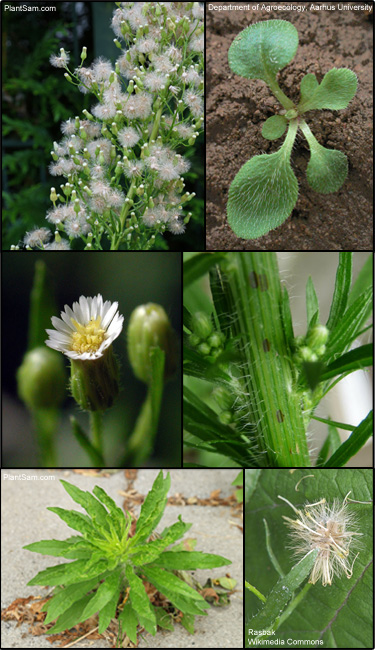Marestail (Conyza canadensis)
 Common Names: Canada fleabane, horseweed, butterweed, fireweed, hogweed
Common Names: Canada fleabane, horseweed, butterweed, fireweed, hogweedDescription: In 2001, it was the first reported weed to have developed a resistance to glyphosate.
Habit: Erect annual with a long taproot and 1 or more stems arising from a basal rosette.
Leaves: Narrow, 4 in. long and less than 1/2 in. wide, smaller as the ascend the stem, edges covered with stiff hairs, toothless, little or no stalk, alternate and crowded.
Stems: Erect, unbranched except near flowers, stout, covered in stiff hairs, may fall from weight of flowers.
Flowers: Large branching cluster at top of plant, 1/8 in. across with 20-40 minute white or pinkish rays (petals), yellow center disk, bracts narrow and smooth to sparsely hairy.
Fruit and seeds: Light brown in color with a tuft of light brown hair.
Habitat: Native to North America. Can be found in fields, prairies, roadsides, railroads, gravel pits, vacant lots, yards and disturbed sites.
Reproduction: By seed.
Similar species: Tall fleabane (Conyza sumatrensis).
Monitoring and rapid response: Satisfactorily controlled by tilling, hand-pulling and crop rotation. Other methods of control have been living mulches of Trifolum subterraneum. Resistance to paraquat and triazines. Biological control with the help of tephritid Procecidochares australis. Credits: The information provided in this factsheet was gathered from CABI: Invasive Species Compendium and Minnesota Wildflowers.
Individual species images that appear with a number in a black box are courtesy of the Bugwood.org network (http://www.invasive.org). Individual photo author credits may not be included due to the small display size of the images and subsequent difficulty of reading the provided text. All other images appear courtesy of Google (http://images.google.com).
Common Name: | Marestail |
Scientific Name: | Conyza canadensis |
Family: | Asteraceae (Aster) |
Duration: | Annual, Biennial |
Habit: | Herbs |
USDA Symbol: | COCA5 |
